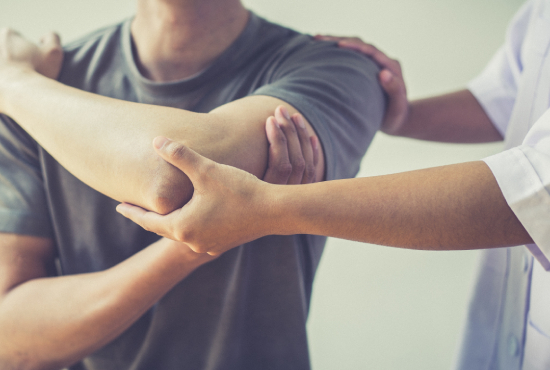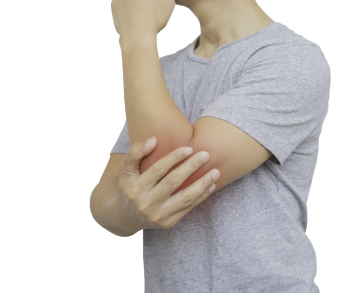Introduction to Arm Pain Physiotherapy
Comprehensive Physiotherapy for Arm Pain Relief
Arm pain, whether from joint issues, muscle strains, or injuries like fractures, can significantly hinder your ability to perform daily activities. At Orthocure, we offer specialized physiotherapy for a wide range of arm conditions, including pain in the shoulders, elbows, and wrists. Our experienced physiotherapists employ various techniques such as manual therapy, tailored exercises, and pain management strategies to alleviate discomfort and enhance arm function. Our goal is to address the root causes of your arm pain and provide practical, personalized treatments that restore mobility and quality of life.

Understanding Arm Pain Challenges
Navigating the Complexities of Arm Conditions
Arm pain can arise from numerous sources, and understanding these is crucial for effective treatment
Common in the wrist and elbow, such as carpal tunnel syndrome or tennis elbow.
Including fractures or dislocations that require precise rehabilitation.
Often due to overuse or improper use, needing targeted physio exercises.
Such as arthritis, which affects shoulder and arm mobility.

Benefits of Physiotherapy for Arm Pain
Enhancing Recovery and Function Through Physiotherapy
The benefits of engaging in physiotherapy for arm pain are vast
Pain Reduction
Techniques like soft tissue massage, ultrasound, or TENS help alleviate pain.
Increased Strength and Mobility
Strengthening and stretching exercises restore function and prevent future injuries.
Improved Circulation
Enhanced blood flow to the affected areas aids in healing and pain relief.
Education and Preventive Measures
Patients learn to maintain arm health and prevent pain recurrence.
Types of Arm Conditions Treated
Effective Treatment for a Spectrum of Arm Issues

Our physiotherapy services effectively treat various arm conditions
Broken Arms
Rehabilitation focuses on healing and regaining full function post-fracture.
Shoulder and Elbow Pain
Treatments reduce discomfort and improve joint mobility.
Forearm and Wrist Issues
Custom exercises and therapies address specific pain points and injuries.
Upper and Lower Arm Pain
Comprehensive care plans address acute and chronic pain management.
The Orthocure Approach to Arm Pain Physiotherapy
Our Proven Strategy for Effective Arm Pain Relief
Detailed Assessment and Custom Plan
Thorough evaluations identify the specific nature of the arm pain.
Personalized Treatment Regimens
Based on individual diagnosis, incorporating manual therapy and exercises.
Advanced Therapeutic Techniques
Utilization of the latest therapies to maximize recovery.
Ongoing Support and Guidance
Ensures patients continue to improve and prevent future pain with lifestyle adjustments and continuous care.
FAQs on Arm Pain Physiotherapy
Physiotherapy for arm pain involves various treatments designed to alleviate pain and restore functionality. Techniques may include manual therapy to manipulate muscles and joints, tailored exercises to strengthen and stabilize the arm, and modalities such as ultrasound or electrical stimulation to reduce pain and inflammation. A physiotherapist will assess the specific causes of your arm pain, possibly due to injuries, overuse, or chronic conditions, and develop a personalized treatment plan. The goal is to improve your ability to perform daily activities without discomfort and prevent future issues.
Physiotherapy is crucial in the recovery process after a fractured arm. It starts with gentle exercises to maintain joint mobility and muscle tone during healing. Once the cast is removed, therapy intensifies to include strength building, flexibility exercises, and joint mobilization to restore full range of motion. Physiotherapists also work on reducing any scar tissue and educating patients on proper arm mechanics to ensure a successful recovery. The therapy helps accelerate healing, enhance functionality, and minimize the risk of stiffness or long-term disability.
Practical physiotherapy exercises for shoulder and upper arm pain typically include range-of-motion, stretching, and strengthening workouts. These involve shoulder rotations, arm lifts, and resistance band exercises to improve muscle strength and joint function. Exercises like wall push-ups or using light dumbbells help strengthen the shoulder and upper arm muscles, supporting the joints and reducing pain. A physiotherapist will tailor these exercises to your specific condition, ensuring they are safe and effective.
Yes, physiotherapy is highly effective in treating chronic arm pain caused by repetitive strain injuries such as tennis elbow or carpal tunnel syndrome. Treatment focuses on reducing inflammation, relieving pain, and correcting poor ergonomic practices that may contribute to the condition. Techniques include manual therapy, ergonomic assessments, and specific exercises to enhance strength and flexibility. Physiotherapy also educates patients on modifying their activities to prevent future occurrences.
Physiotherapy plays a vital role in rehabilitating forearm injuries by helping to restore strength, mobility, and functionality. The treatment plan for a forearm injury might include exercises to improve motion, strength training to rebuild muscle, and manual therapy to enhance circulation and tissue healing. Additionally, physiotherapy can provide pain management techniques and strategies to avoid re-injury as the forearm heals. This comprehensive approach ensures a balanced recovery, targeting the injury’s symptoms and underlying causes.
Physiotherapy treats arm pain from sports injuries by first reducing pain and swelling through ice, compression, and elevation. Once acute symptoms are managed, the focus shifts to restoring range of motion and strength through specific exercises and manual therapy. Rehabilitation also includes sport-specific drills to ensure athletes can return to their sport safely and effectively. Preventive education is also crucial, teaching athletes how to warm up properly and avoid movements that could lead to re-injury.
During your first physiotherapy session for arm pain, the therapist will conduct a thorough assessment, which includes a detailed history, physical examination, and possibly diagnostic tests. This initial evaluation helps to identify the root cause of the arm pain, whether it’s an injury, chronic condition, or post-surgical complication. You’ll discuss your symptoms, functional limitations, and treatment goals. Based on this assessment, the physiotherapist will develop a personalized treatment plan that may include exercises, manual therapy, and education on arm care.
Physiotherapy is essential after arm surgery to speed up recovery, reduce pain, and enhance the range of motion. Starting physiotherapy early can prevent complications such as stiffness and muscle atrophy. Therapists initially use gentle passive movements and gradually introduce active exercises as healing progresses. This approach ensures faster and more comprehensive recovery, addressing strength and functionality. Education on proper arm care and gradual reintroduction to daily activities are critical components of post-surgical rehabilitation.
The duration to see improvements in arm pain with physiotherapy can vary depending on the underlying cause of the pain, the severity of the injury, and the patient’s overall health and commitment to the treatment plan. Generally, patients may improve within a few weeks of consistent therapy. However, complete recovery, especially for more severe conditions or post-surgical rehabilitation, might take several months. Regular assessments by the physiotherapist help tailor the treatment as the patient progresses.
Physiotherapy for arm conditions is generally safe when performed by a qualified therapist. However, like all treatments, it carries some risks, primarily if exercises are performed incorrectly or the intensity needs to be lowered initially. Some patients may experience increased pain or discomfort as their bodies adjust to the new activities. Communicating any discomfort experienced during therapy is crucial to ensure the treatment plan is adjusted to suit your tolerance and recovery pace.
While physiotherapy is highly effective in managing and often resolving many types of arm pain, some chronic conditions or severe injuries may require ongoing management or additional interventions. Physiotherapy provides significant relief by addressing mechanical issues and improving strength and flexibility, but adjunct treatments like medication or, in some cases, surgery may be necessary. A multidisciplinary approach may offer the best complex or persistent arm pain outcomes.
Physiotherapy offers various preventive measures to prevent future arm injuries, including strength and conditioning programs, ergonomic assessments, and education on proper body mechanics. By strengthening the muscles and improving flexibility, physiotherapy helps protect against the strain that can lead to injuries. Therapists also provide specific advice tailored to individual lifestyles or sports, helping to minimize the risk of recurring issues.
Physiotherapy for arm pain is highly tailored to meet individual needs based on the specific diagnosis, severity of symptoms, and patient goals. After a thorough assessment, physiotherapists design a personalized treatment plan that may include manual therapy, therapeutic exercises, and pain management strategies. They consider factors like age, activity level, and occupational demands to ensure the treatment is relevant and practical, providing a bespoke approach to each patient.
For upper arm muscle pain, physiotherapy techniques that prove particularly effective include manual therapy to reduce muscle tension, therapeutic exercises to strengthen and stabilize the shoulder joint, and modalities such as heat or cold medicine to alleviate pain. Stretching exercises are also crucial for maintaining flexibility and preventing stiffness. Additionally, trigger point therapy and soft tissue massage can be very beneficial in relieving muscle knots and enhancing circulation.

